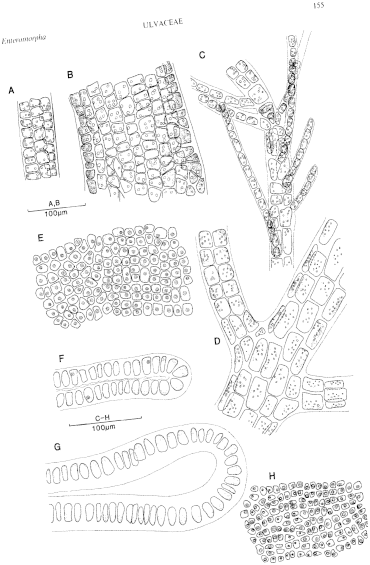|
|
|
|
|
|||||||||||
|
Electronic Flora of South Australia Species Fact Sheet
Phylum Chlorophyta – Order Ulvales – Family Ulvaceae
Selected citations: Bliding 1939: 139, figs 4–7; 1963: 127, figs 79–81. Phillips & Clayton 1983: 11, figs 1–8. Womersley 1956: 353.
Thallus (Fig. 48C) medium green, surface smooth and "silky", simple, margin smooth to slightly flounced, basally attached by a small holdfast and broadening usually rapidly to a flat, cuneate to elongate blade, 2–10 (–20) cm high and 2–8 (–10) cm broad; stipe short, tubular; blade almost completely compressed apart from a narrow marginal cavity (Fig. 49F, G), with the two layers separated by mucilage and moderately adherent (Fig. 49F). Cells in longitudinal and often in transverse rows (Fig. 49E), often curved around growth centres, square to rectangular in surface view, (13–) 16–22 µm long and 10–16 µm broad; chloroplast laminate, with a single prominent pyrenoid.
Reproduction: Reproduction by quadriflagellate zoo (mito) spores and occasionally by biflagellate zooids (Phillips & Clayton 1983, p. 15)
Type from Europe; lost.
Selected specimens: St Kilda, S. Aust., 1.5 m deep on Posidonia (Lewis, 23.viii.1972; ADU, A42719). Rosetta Bay, Victor Harbor, S. Aust., 0–1 m deep (Hone, 20.vi.1982; ADU, A53312 and 4.viii.1982; ADU, A53344). Port Phillip, Vic. (see Phillips & Clayton 1983).
Distribution: Widely reported in temperate seas.
In southern Australia known definitely from the localities listed below, with doubtful records from Tasmania and N.S.W.
Taxonomic notes: Phillips & Clayton (1983) have shown that E. linza is often common in and near Port Phillip, Vic. and while not as common as some species of Enteromorpha, it is probably frequent in bays and on coasts with moderate water movement. However, many species in herbaria named as E. linza are complanate forms of E. compressa.
E. linza is distinguished by its unbranched, smooth ("silky") thallus, the fairly close adherence of the two layers with only the very margins saccate and the prominent rows of fairly large cells, each with a fairly large pyrenoid.
References:
BLIDING, C. (1939). Studien über entwicklung und systematik in der gattung Enteromorpha. II. Bot. Notiser 1939, 134–144.
BLIDING, C. (1963). A critical survey of European taxa in Ulvales. Part I. Capsosiphon, Percursaria, Blidingia, Enteromorpha. Opera Bot. 8(3), 1–160.
PHILLIPS, J.A. & CLAYTON, M.N. (1983). Morphology and development in culture of Enteromorpha linza (L.) J. Agardh (Ulvaceae, Chlorophyta), a common marine alga of southern Australia. Aust. J. Bot. 31, 11–18.
WOMERSLEY, H.B.S. (1956). A critical survey of the marine algae of southern Australia. I. Chlorophyta. Aust. J. mar. freshw. Res. 7, 343–383.
The Marine Benthic Flora of Southern Australia Part I complete list of references.
Publication:
Womersley, H.B.S. (31 May, 1984)
The Marine Benthic Flora of Southern Australia
Part I
©Board of the Botanic Gardens and State Herbarium, Government of South Australia
Illustrations in Womersley Part I, 1984: FIGS 48C, 49 E–G.

Figure 48 enlarge
Fig. 48. A. Enteromorpha ralfsii (ADU, A52642). B. Enteromorpha paradoxa (ADU, A22574). C. Enteromorpha linza (ADU, A53344). D. Enteromorpha prolifera (ADU, A14129). E. Enteromorpha flexuosa (ADU, A43697).

Figure 49 enlarge
Fig. 49. A,B. Enteromorpha ralfsii. A. Part of slender filament (ADU, A52642). B. Part of broader filament (ADU, A53180). C,D. Enteromorpha paradoxa (ADU, A43736). C. Young part of thallus. D. Older part of thallus. E–G. Enteromorpha linza (ADU, A53312). E. Surface view of cells. F. Cross section of young thallus margin. G. Cross section of older thallus margin. H. Enteromorpha prolifera (ADU, A21045). Surface view of cells.

|
Email Contact: State Herbarium of South Australia |

|